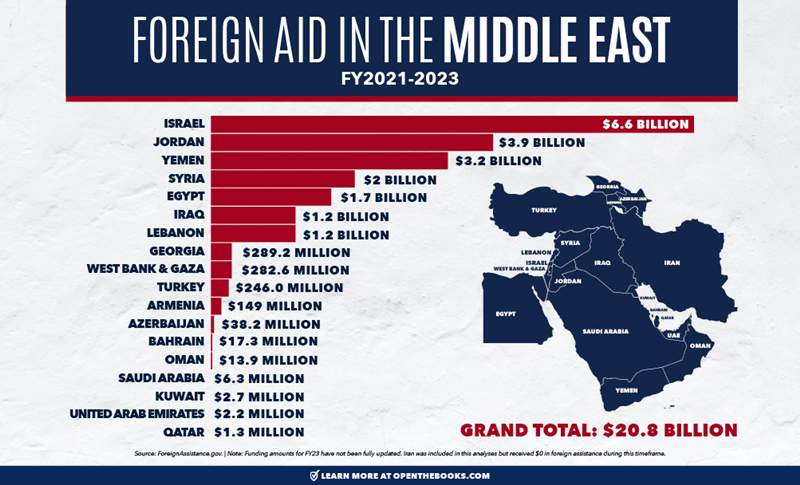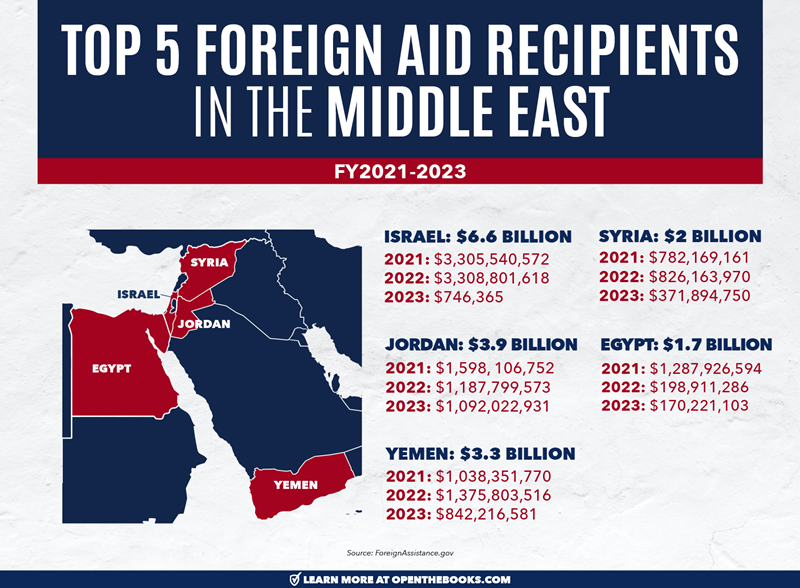

By Adam Andrzejewski, OpenTheBooks CEO/Founder | Published at Substack
TOPLINE: Seventeen Middle Eastern countries, plus Egypt, received $20.8 billion in U.S. foreign aid during the Biden administration in fiscal years 2021-2023, according to U.S. government disclosures. Israel received $6.615 billion. Jordan and Yemen received the next highest funding levels, with $3.8 and $3.2 billion, respectively.
Hamas’ terrorist attacks against Israel on October 7 claimed more than 1,400 lives. Neighboring Middle Eastern countries soon spoke out against Israel taking some retaliatory measures. Principally, they objected to Israel causing civilian casualties by invading Gaza to rescue Israel and U.S. hostages taken October 7, and to eliminate Hamas once and for all.
Auditors at OpenTheBooks.com decided to take a closer look at foreign aid spending in the region. The countries in the “Middle East” are defined by the United Nations“based on geographical and climatic homogeneity.”
Note: Iran didn’t receive direct taxpayer dollars, but an estimated $50 billion from loosed sanctions, unfrozen assets, and other policy changes by the Biden administration. Furthermore, the Biden administration restarted $1 billion in Palestinian aid through the United Nations after a Trump freeze.
Critical Quote: What is Foreign Aid?
“Foreign assistance is provided by the United States to other countries to support global peace, security, and development efforts, as well as to provide humanitarian relief during times of crisis. The U.S. government provides foreign assistance because it is strategically, economically, and morally imperative for the United States and vital to U.S. national security.” Source: ForeignAssistance.gov, an official U.S. government website.

Regional Funding and Relationships
Since its founding in 1948, Israel has had fraught relations with neighboring countries. It has frequently been at war to defend its existence as a Jewish country. While relations had improved in recent years, the Hamas attack on Israeli civilians has reignited regional tensions.
Israel
Israel has received the highest level of funding in the Middle East over the past three years. Almost all of this funding—$6.6 billion—came from the “foreign military financing program” in 2021 and 2022, which aims to help “the procurement of defense articles, defense services, and design and construction services.”
Jordan
The next highest funding recipient is Jordan, which shares a border with Israel and the Palestinian territory of West Bank. Jordan received $3.8 billion from 2021-2023. About 40% of that, $1.39 billion, was in the form of two “cash transfers to the government of Jordan” from USAID in 2021 and 2023.
A USAID Inspector General report notes that as of April 2022 the cash transfers to Jordan were the largest amount of budget support given to any foreign country worldwide.
Jordanian leaders King Abdullah II bin Al-Hussein and his wife Queen Rania Al-Yassinhave both called for a blanket ceasefire in the region, a prospect Israel and its Western allies have rejected considering the existential threat Hamas poses to Israel. Jordan, which already hosts hundreds of thousands of refugees, has refused to take in refugees from Gaza or West Bank.
Yemen
Yemen has received the next most funding at $3.2 billion. Yemen is a country with deep internal conflicts; a rebel organization called the Houthis controls territory home to an estimated 70-80% of the Yemeni population. The Houthis are closely linked to and funded by Iran, and have committed terrorist activities in Saudi Arabia and, more recently, launched missiles at Israel.
The Houthis have claimed three missile attacks on Israel since the October 7, promising more to come. The group’s slogan is “Death to America, death to Israel, curse the Jews and victory to Islam.”
A little less than half of the U.S. foreign assistance to Yemen—$1.4 billion—is involved in the USAID Title II Emergency Program, which typically buys food in the United States and transports it abroad. Another $614 million is used for activities labeled “humanitarian assistance.”
Syria
Syria has received $1.9 billion in U.S. foreign aid. Since the Hamas attacks on Israel, U.S. Ambassador Linda Thomas-Greenfield accused Syria of allowing Iran to use its international airports for military activities and for sponsoring terrorist groups within its borders to launch attacks against Israel.
According to an AP News report, Thomas-Greenfield said:
“The United States has warned all actors not to take advantage of the situation in Gaza to widen or deepen the conflict. And we’ve made clear that we will respond to attacks on our own personnel and facilities in Syria or against U.S. interests, and where appropriate exercise our right to self-defense forcefully, proportionately and in a manner that minimizes civilian harm.”
Israel has conducted retaliatory missile strikes on Syrian military targets.
$1.6 billion in U.S. aid to Syria is related to “humanitarian assistance” activities. Other funding includes:
-
$5 million for “Strengthen Community Resilience in Northwest Syria Activity” in 2023.
-
$7.2 million for “Agriculture.”
-
$7.4 million to “address USAID efforts to support the Syrian civil defense.”
Egypt
Egypt has received $1.5 billion in U.S. foreign aid from 2021-2023. Most of this funding came in a single obligation in 2021—$1 billion for foreign military financing.
Other sources of funding include:
-
$26 million in2023 “to strengthen the higher education system to address Egypt's development priorities.”
-
$15 million in 2022 to “promote women's access to economic opportunities.”
-
$20 million from 2021-2023 to create a “cadre of change agents and problem solvers who have an understanding, experience and appreciation of development and democratic processes and values.”
Egypt shares a border with Israel and Gaza. The two countries fought multiple wars before Egypt became the first Arab state to recognize Israel formally in January 1980. The countries have had more friendly relations in recent years and are known to cooperate closely on security matters.
While Egypt has rejected Israeli overtures to take in Gaza refugees and has condemned Israel’s strikes in Gaza, the country has agreed to treat injured Gazans in its hospitals.
Examples of Foreign Aid:
Most funding is from U.S. Agency for International Development, but other agencies fund foreign assistance as well, such as the Departments of Interior, State, Energy, and Agriculture. However, funding frequently goes to projects that have little plausible connection to U.S. strategic or economic imperatives. Examples include:
-
Jordan, 2022, $4.5 million, USAID, “Recycle Jordan”—The public relations campaign is an attempt to expand and improve private sector-led recycling services, generate greater demand for and usage of recycling services within the Amman commercial sector and increase local and national government support for solid waste management.
-
-
Saudi Arabia, 2022, $338,707 Department of Interior, “Catalyzing Cheetah Conservation” – The expensive public relations campaign aims to convince wealthy Saudis to stop having cheetahs as pets. It focuses on “addressing or understanding the drivers of [cheetah] demand, especially using the lens of social behavior change communications” to reduce demand for cheetahs in the Arabian Peninsula.
-
-
West Bank and Gaza, 2022; $3.29 million, USAID, “Women Entrepreneurship Development” – A program to “provide businesswomen with training, seed funding, and connections with successful entrepreneur mentors.” The U.S. spent $800 million in Afghanistan on a comparable respect women campaign with little impact.
BACKGROUND: U.S. spending $50 Billion on foreign aid annually
In 2021, our auditors at OpenTheBooks.com published a comprehensive oversight report on U.S. foreign aid. Only two U.S. state governments – California and New York – received more federal dollars than we send overseas for foreign aid.
ADDITIONAL READING:
Biden Policies Delivered $50-$60 Billion To Iran, World’s Top Terror Sponsor | OpenTheBooks.com | October 30, 2023
Biden Pays, Rockets Fly: Administration Sent $1 Billion In Palestinian Aid After Trump’s Freeze | OpenTheBooks.Substack.com | October 17, 2023
Biden Reversed Trump’s Foreign Aid Freeze To Expand Palestinian Funding—$6.3 Billion Since 1953 | Forbes | Adam Andrzejewski | May 2021
U.S. Resumption of Foreign Aid To The Palestinians | Congressional Research Service | April 2021
Mortar And Rocket Attacks Against Israel By Date | The Jewish Virtual Library, A Project of AICE | 2001 to the Present